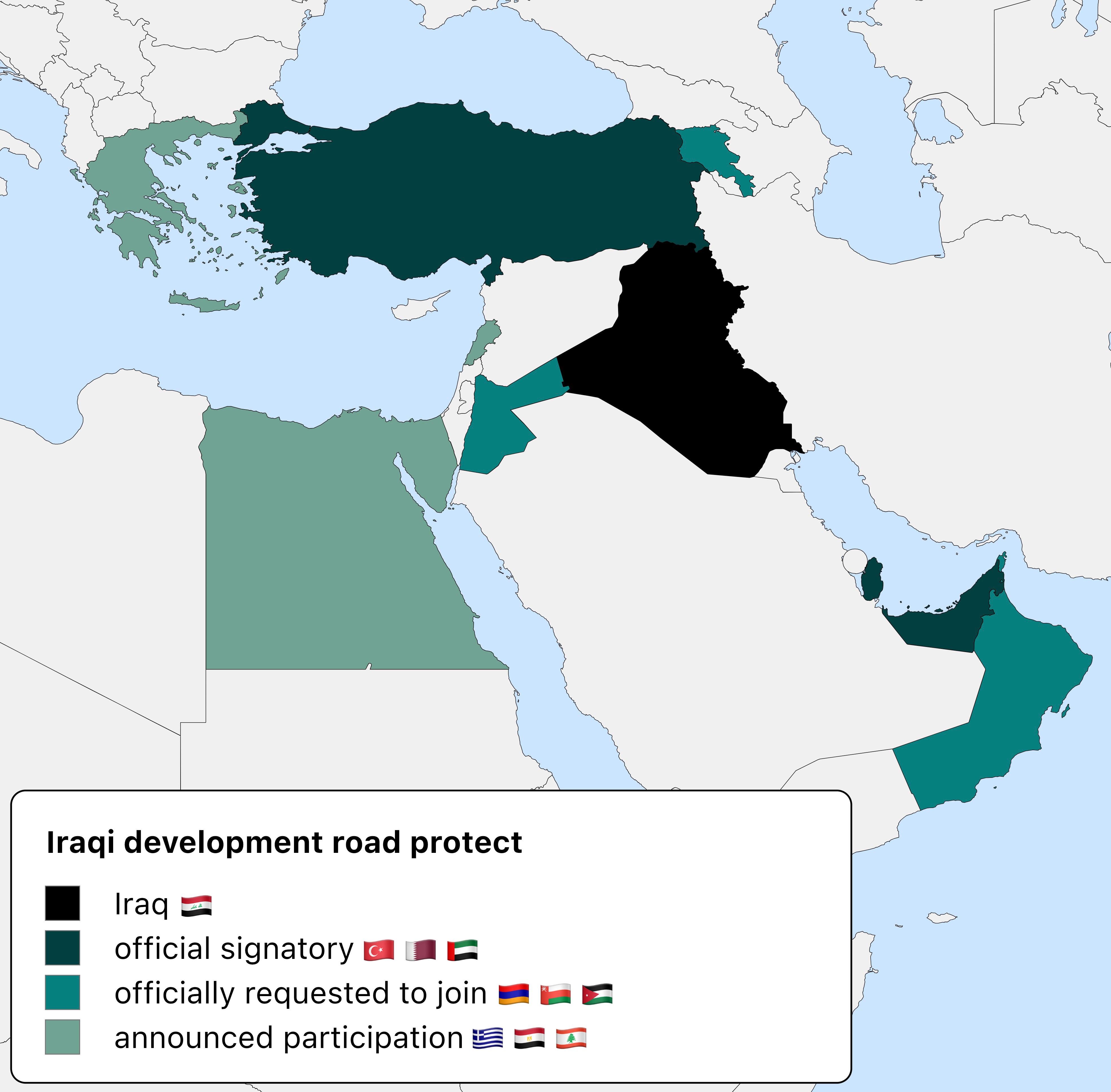Iraq Development Road Project Countries Involved Map


David Chen
Data Visualization Specialist
David Chen is an expert in transforming complex geographic datasets into compelling visual narratives. He combines his background in computer science ...
Geographic Analysis
What This Map Shows
This map illustrates the countries involved in Iraq's ambitious Development Road Project, a monumental infrastructure initiative designed to establish a robust trade and transport corridor linking Europe with the Persian Gulf. Stretching approximately 1,200 kilometers from the Al-Faw Grand Port in southern Iraq to the Turkish border in the north, the project aims to revolutionize regional connectivity through a combination of a high-speed highway and a dual-track electrified railway. This integrated transport network will not only facilitate the movement of goods and passengers but also significantly reduce shipping times between Asia and Europe, offering a reliable alternative to the Suez Canal.
Deep Dive into the Development Road Project
The Development Road Project is more than just a transport corridor; it symbolizes Iraq's potential as a key player in global trade. Designed to enhance connectivity between the Gulf region, Iraq, Turkey, and Europe, this project is poised to transform the landscape of international logistics. The initiative supports a dual approach: a highway for road transport and a railway for quicker freight services.
What’s fascinating is how this project can reshape economic dynamics in the region. Currently, shipping goods from Asia to Europe via the Suez Canal can be time-consuming and fraught with risks, especially with the increasing maritime security challenges in the Red Sea. By providing a land-based alternative, the Development Road Project not only promises faster transit times but also a more stable and secure trade corridor.
To understand the significance of this initiative, consider the statistics: the project aims to handle millions of cargo tons annually, connecting key economic hubs. Countries involved in this initiative include Iraq, Turkey, and potentially Iran, along with trade partners in Europe. Each of these nations stands to benefit from enhanced trade opportunities and economic growth, making this project a focal point for regional development.
Moreover, the electrified railway component will likely facilitate efficient passenger travel, promoting tourism and cultural exchange between countries. With the growing demand for sustainable transportation solutions, this railway could also serve as a model for future infrastructure projects in other regions.
Regional Analysis
The map highlights the countries directly involved in the Development Road Project, notably Iraq and Turkey. Iraq, with its strategic location, is positioning itself as a logistical hub, while Turkey serves as a critical gateway to Europe. The Turkish region bordering Iraq is expected to see significant economic stimulation as trade flows increase.
Interestingly, the project may also spark interest from neighboring countries such as Iran, which could seek to integrate its transport routes with this corridor. The dynamics of trade within the Gulf Cooperation Council (GCC) could shift if Iran engages more actively in this initiative, potentially enhancing its trade relations with Turkey and the broader European market.
In contrast, the European nations at the end of this corridor also stand to gain. Countries like Greece and Italy, which are traditionally the endpoints for maritime routes from Asia, may find new advantages in overland freight that could reduce costs and transit times. This shift could lead to a reevaluation of existing trade agreements and logistics strategies across the continent.
Significance and Impact
Why does this initiative matter? The Development Road Project is not just about infrastructure; it represents a pivotal shift in global trade patterns. As the world increasingly seeks to diversify supply chains and reduce reliance on maritime routes, projects like this become essential. The ability to move goods swiftly and securely overland will likely influence not only trade but also geopolitical relations among the involved nations.
Current trends suggest that, as economies recover from global disruptions, investments in infrastructure will be key to driving growth. The development of the Iraqi corridor could position Iraq as a central player in the trade landscape, allowing it to leverage its geographical advantages. Additionally, as countries prioritize sustainable development, the electrified railway could become a benchmark for green transport solutions in the region.
Looking ahead, the successful implementation of the Development Road Project could inspire similar initiatives in other parts of the world, fostering greater connectivity and cooperation among nations. With advancements in technology and logistics, the potential for increased trade and cultural exchange is boundless, making this project a fascinating subject for anyone interested in the future of global trade and geography.
Visualization Details
- Published
- October 22, 2025
- Views
- 26
Comments
Loading comments...